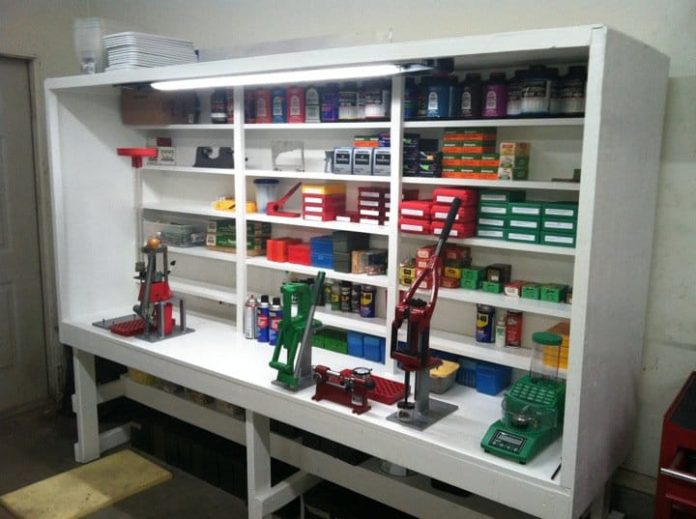
Reloading done properly is safe, efficient, economical, and most would say, a lot of fun. Done improperly…. well, that is where it is possible to damage firearms and occasionally, people.

There are a limited number of basic steps involved once you select the cartridge you want to load (there are more – and more precise – steps for specialty reloading applications):
- Selection of a load
- Accumulation of the four components – brass, primers, powder, and bullet
- Preparation of the brass
- Priming the brass
- Measuring powder and charging the case
- Seating the bullet
- Crimping the finished cartridge
- Testing the finished load at the range
As simple as the basics are, there are a number of places where one can go horribly wrong without sufficient knowledge or guidance. While the sourcing and prepping of brass is relatively straightforward, there is a lot of confusion over what constitutes a safe load. Even if you abide by one of the cardinal rules of reloading –
For any given load, never load under the “minimum” recommended charge weight for a specific powder, and never load over the “maximum” recommended charge weight for that same powder
– if you selected the wrong manual in the first place you could choose a “minimum” charge weight in your manual of choice that exceeds the “maximum” charge weight in other respected manuals! I’ve done it. And after consulting with Hornady and their reloading experts, I learned the only practical solution years ago, which, unfortunately, is to this day not sufficiently stressed in most sources of guidance about reloading – the use of a minimum of two current mainstream manuals. The rule? Never work up a load you can’t find that is, for all intents and purposes, the same in both manuals. The best advice for a beginner is to start with the current manual published by the manufacturer of the powder he or she selects and then match up the load data with the current manual published by the chosen bullet manufacturer.
Weighing powder is another area for potential error, and danger, if safe practices aren’t followed. You are expected to be able to weigh powder to 1/70,000th of a pound. That’s tiny. So small, in fact, that some complete powder charges weigh far less than you could even feel in the palm of your hand if you weren’t looking at the powder to know it was there. Yet you need to know how to weigh with this degree of accuracy with equipment that costs as little as $25-$50. You can easily learn this skill and I can teach you how in a few easy steps.

While on the subject of weighing powders, many reloaders purchase a scale and then use it right out of the box. That sounds straightforward on the surface, until they find out – or not – that their scale could be 2/10ths or 5/10ths of a grain or even more out of calibration, even when checked with the calibration weights supplied with most scales. You need to learn how to source – and properly use – calibration weights beyond what is supplied with the scales. Why? Because this sort of error could be greater than the entire range for the charge weight between the minimum and maximum published loads.
Another powder-related area of risk is the “double charge.” Depending on your reloading practices and equipment, you can run the risk of dropping two charges of powder in a single case. For some loads that may still be within the acceptable pressure range (between published minimum and maximum) where the end result may simply be an unpleasant surprise when one pulls the trigger. In other cases, however, it can create combustion pressure well beyond the manufacturing tolerances of the firearm. The potential outcome here is for parts of a firearm to bulge where it was never designed to bulge, and in a worst-case scenario, pieces of metal flying off that were never designed to leave the gun.
Another area of confusion and often disagreement: Can any components be safely substituted? Some substitutions can be made, with the right practices and under the right circumstances. Some substitutions are downright dangerous.
When should you crimp and when can you safely skip crimping the mouth of the case? Even the manuals published by some of the biggest names in reloading give only cursory coverage to this topic. And many manuals don’t advise you beyond telling you to apply the “crimp desired.” What’s desired? What’s necessary? What’s safe? How does one know the difference?

Want to know all this and more? While written primarily for the beginning reloader, my book, “Things They Don’t Tell You About Reloading” contains information that even seasoned reloaders find useful. I have had students taking my reloading classes who, before the evening was out, purchased additional equipment so that they could make their current practices safer.
Learn what steps are necessary and what are optional when prepping brass. Learn when – and how – to properly lube cases for resizing. Learn when you can and cannot safely substitute brass, primers or bullets. Learn how to confidently weigh to one tenth of one grain – that is, 1/70,000th of a pound! Learn when and how to properly crimp cases. How to avoid a double charge. How to keep from damaging bullets and/or cases when seating bullets. Learn if you can rely on the “signs of excessive pressure” to tell you when a load is too hot. Or when you may have headspace problems. And – something I have never found in any reloading book – how to properly test your new load at the range for, among other things, bullet creep.
Joel Guerin, Metallic Cartridge Reloading Instructor
Versailles, Kentucky



